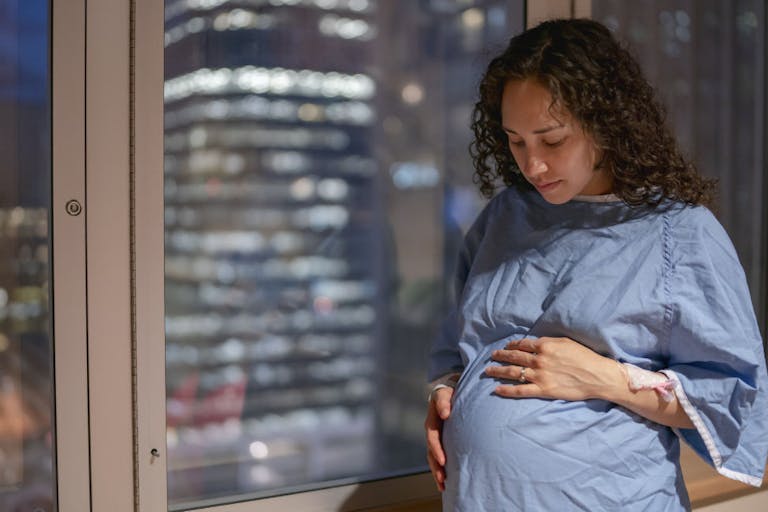
Welsh women denied needed pregnancy medication are getting abortions
Cassy Cooke
·
NPR pushes false narrative that insurance denied woman’s ‘life-saving abortion’
A Wisconsin couple claims they were denied a ‘necessary’ abortion when the wife experienced a miscarriage during her first pregnancy, and that she needed a “life-saving” abortion during her second pregnancy. This story is another example of how abortion advocates exploit circumstances and conflate authentic health care with induced abortion to garner support for legalized abortion on demand.
Miscarriage treatment is not an abortion
Ashley and Kyle were expecting their first child in 2022, but Ashley told NPR that at seven weeks pregnant, and just a few weeks after Roe v. Wade fell, she began miscarrying. At this point, a pro-life law was in effect in Wisconsin protecting most preborn babies from abortion. Abortion was allowed in the state only to save the life of the mother (though induced abortion — the direct and intentional killing of a preborn child — is not medically necessary).
NPR reported, “Ashley’s life wasn’t in danger during the miscarriage, but the state’s abortion ban meant doctors in Wisconsin could not perform a D&E — dilation and evacuation — even during a miscarriage until the embryo died.”
First of all, an abortion at seven weeks would not be a D&E (dilation and evacuation), because D&Es are carried out after the first trimester. Instead, it would have been a D&C procedure; if used to intentionally kill the baby, this would have been prohibited by the state, but it would not be prohibited to remove a deceased baby from the womb. Sometimes a woman experiences the threat of a miscarriage but the pregnancy continues. According to Cleveland Clinic, a study found that of the 25% of women who experience bleeding in the first 20 weeks of pregnancy, 60% go on to carry the baby to term.
Once Ashley’s baby had died, however, doctors did administer miscarriage treatment.
The standard of care for a confirmed miscarriage is not typically to immediately treat with a D&C surgery or to administer misoprostol to induce contractions. At first, doctors frequently advise a ‘wait-and-watch’ approach to allow the miscarriage process to take place naturally. If that does not happen, it would be considered a missed miscarriage, and doctors may prescribe misoprostol or schedule a D&C if they deem surgery is necessary. A D&C is often the last resort.
However, since Dobbs, women have been led to erroneously believe that not being given an immediate D&C for miscarriage is the fault of pro-life laws. It’s not. Both misoprostol and a D&C carry risks and would only be advised if necessary. Once it was deemed necessary, Ashley received treatment.
Though a D&C is used to treat both early induced abortion and early miscarriage, they are not equal in intent. A D&C following a miscarriage is not an induced abortion and is not prohibited by any law, because it is not being carried out with the intention of producing a dead preborn child; an induced abortion intends to cause the child’s death.

Dr. Susan Bane, an OB/GYN, explained to Live Action News that doctors know the difference between a D&C for miscarriage (child has already died) and a D&C for induced abortion (child is intentionally killed). But, since the Dobbs decision was handed down, the pro-abortion American College of Obstetricians and Gynecologists (ACOG) has been rewriting its language to fit the abortion industry’s goal of creating chaos to boost support for legalized abortion.
“A month after Dobbs, I was on a national webinar with The Hastings Center and a Harvard professor with ACOG was there,” Bane told Live Action News. “Someone put in chat: ‘Can we please all agree on what type of abortion we’re talking about with the Dobbs decision? We’re talking about induced abortions, which we all know are different.’ This doctor [from Harvard and ACOG] immediately said a miscarriage is an abortion. Miscarriage is under the umbrella of abortion [as ‘spontaneous abortion’] but it’s not an induced abortion.”
She continued, “D&Cs are not outlawed in any state. … There’s not a single law in all 50 states that prevents a woman that has a miscarriage or life-threatening condition that prevents health care in all of those situations.”
Abortion is not a treatment for preterm premature rupture of membranes
During her second pregnancy, Ashley suffered preterm premature rupture of membranes (PPROM), in which the water breaks prematurely. Ashley said she was told she would need an induced abortion to save her life.
“Everything was perfect. I was starting to feel kicking and movement,” said Ashley. “It was the day I turned 20 weeks, which was a Monday. I went to work, and then I picked Kyle up from work, and I got up off the driver’s seat and there was fluid on the seat.”
NPR reported that her baby “was deemed too underdeveloped to survive, and the ruptured membranes posed a serious threat of infection.” And yet, according to NPR, Ashley did not have an infection or signs of infection:
Obstetrician-gynecologists from across Wisconsin had decided that “in cases of previable PPROM, every patient should be offered termination of pregnancy due to the significant risk of ascending infection and potential sepsis and death,” said Eliza Bennett, the OB-GYN who treated Ashley.
Bane, however, confirmed to Live Action News that induced abortion is not the standard of care for PPROM and that in her 25 years of practice, she has treated hundreds of cases of PPROM and none of those women had to have an induced abortion. She cited the Center for Disease Control’s (CDC) definition of “legal induced abortion,” which is “an intervention performed by a licensed clinician … within the limits of state regulations, that is intended to terminate a suspected or known ongoing intrauterine pregnancy and that does not result in a live birth (emphasis added).”
Bane added that if the doctors did not offer expectant management and potential preterm delivery to Ashley, they would be guilty of malpractice.
Ashley’s case is an example of a situation that has been playing out repeatedly since Dobbs.
“I think for me the most disturbing part of the article was when they said the obstetricians in Wisconsin had decided ‘in cases of PPROM, every patient should be offered termination of pregnancy due to the significant risk of ascending infection and potential sepsis and death.’ So that makes it seem like they’re not including the option of expectant management to these women and I think that’s what we’re seeing more and more since Dobbs,” said Bane.
Article continues below
Dear Reader,
In 2026, Live Action is heading straight where the battle is fiercest: college campuses.
We have a bold initiative to establish 100 Live Action campus chapters within the next year, and your partnership will make it a success!
Your support today will help train and equip young leaders, bring Live Action’s educational content into academic environments, host on-campus events and debates, and empower students to challenge the pro-abortion status quo with truth and compassion.
Invest in pro-life grassroots outreach and cultural formation with your DOUBLED year-end gift!
She added:
If there’s any risk to a pregnancy, instead of doing our job and taking care of both of our patients, there’s this move in our field to end the fetal life. So this is the perfect example of that. … What I would do is I would follow the woman and I can look for signs and symptoms of infection.
So if she started getting a temperature or her abdomen started getting tender or the baby’s heart rate is going up really high and other signs, I would start to have really hard conversations with her: ‘I’m worried you might be getting infected and that can be life-threatening for you if it gets serious enough and we may have to consider moving toward delivery.’ I have had to deliver hundreds of babies in this situation over the last 25 years but I’m not doing an abortion on those babies.
What’s really important here is intention matters.
Bane explained that in this situation if delivery must happen, doctors should do everything they can to save the baby’s life. Babies as young as 21 weeks have survived and even if the woman’s water breaks too soon, she may not necessarily be having contractions or in labor. Doctors would give the baby steroids to mature the lungs so that if an infection did set in, and the baby had to be delivered, the baby would have a better chance at survival.
An abortion, however, would ensure that the baby dies and doctors understand that an induced abortion carries the intent for the fetal patient to die, Bane says.
Though Ashley was given an unnecessary abortion, she complained that her health insurance would not cover it.
Insurance coverage for abortion
Ashley’s health insurance, the Federal Employees Health Benefits Program, said it would not cover her induced abortion during her second pregnancy, though it did pay for her hospital room and other charges.
NPR wrote that Ashley’s insurance carrier is part of FEP Blue and is required to comply with legislation that prohibits the coverage of procedures, drugs, and supplies related to abortion except when the life of the mother is at risk or when the woman is pregnant from rape or incest.
Ashley said the insurance company told her, “[Q]uote, ‘FEP Blue does not cover any abortions whatsoever. Period. Doesn’t matter what it is. We don’t cover abortions.”
“Every time I called insurance about my bill, I was sobbing on the phone because it was so frustrating to have to explain the situation and why I think it should be covered,” she said. Because of her PPROM, she believed she had no choice but to abort her child — and therefore, felt that insurance should pay for the abortion as though it were “life-saving” care.
But she was wrong on both counts.
Her life was not at risk. She was at risk of developing an infection that may or may not have ever happened. She was only one week shy of 21 weeks, and doctors could have worked to save her baby’s life. But instead, they intentionally killed her baby.
Induced abortion is not medically necessary. Every induced abortion is elective. If a pregnancy must end to save the mother’s life, the baby can be born via preterm delivery or emergency C-section — which are not legally considered abortions. The baby may not survive due to prematurity, but would not be killed intentionally.
There is a huge difference here that is being ignored by the media, amid ACOG’s efforts to intentionally confuse the language by redefining life-saving procedures.
ACOG recently began labeling the term “maternal-fetal separation” — such as emergency C-sections and preterm deliveries — as deceptive, claiming these procedures to be the same as induced abortions. This is false. They are not and never have been considered the same, but this explains why Ashley and so many other women are confused.
Dr. Bane said:
One of the best analogies I give is, picture if you and I were out in a boat 20 miles offshore in the ocean and it was going to capsize if one of us didn’t get out. And you said, ‘Susan, I’m going to get out.’ You get out of the boat to save my life. You’re not getting out of the boat to commit suicide. If the Coast Guard came to get me, you’d get in the Coast Guard boat with me.
We’re having to separate our patients. One has to get out of the boat, but the intention isn’t to end the life. We’re the Coast Guard. We’re going to try to save the baby’s life.
These [pro-abortion] doctors aren’t trying to do that.
Eventually, after several appeals, the insurance carrier appears to have been pushed into paying for the abortion — $1,700. And Ashley is now pregnant again, while the media exploits the tragic deaths of her children to support the legalized killing of all children in the womb.
NPR used this opportunity to promote legalized abortion and attack the Hyde Amendment, a long-time target of abortion advocates. The Hyde Amendment has been passed every year since 1976 by Congress and prohibits federal funds from being used to pay for abortions except in cases of rape, incest, or the life of the mother. Pro-abortion legislators want all abortions to be taxpayer-funded, because making them “free” makes abortions more appealing to women.
Live Action News is pro-life news and commentary from a pro-life perspective.
Contact editor@liveaction.org for questions, corrections, or if you are seeking permission to reprint any Live Action News content.
Guest Articles: To submit a guest article to Live Action News, email editor@liveaction.org with an attached Word document of 800-1000 words. Please also attach any photos relevant to your submission if applicable. If your submission is accepted for publication, you will be notified within three weeks. Guest articles are not compensated (see our Open License Agreement). Thank you for your interest in Live Action News!

Cassy Cooke
·
Issues
Bridget Sielicki
·
Issues
Nancy Flanders
·
Politics
Bridget Sielicki
·
Issues
Sheena Rodriguez
·
Guest Column
Right to Life UK
·
Issues
Nancy Flanders
·
Human Interest
Nancy Flanders
·
Investigative
Nancy Flanders
·
Pop Culture
Nancy Flanders
·
Human Interest
Nancy Flanders
·